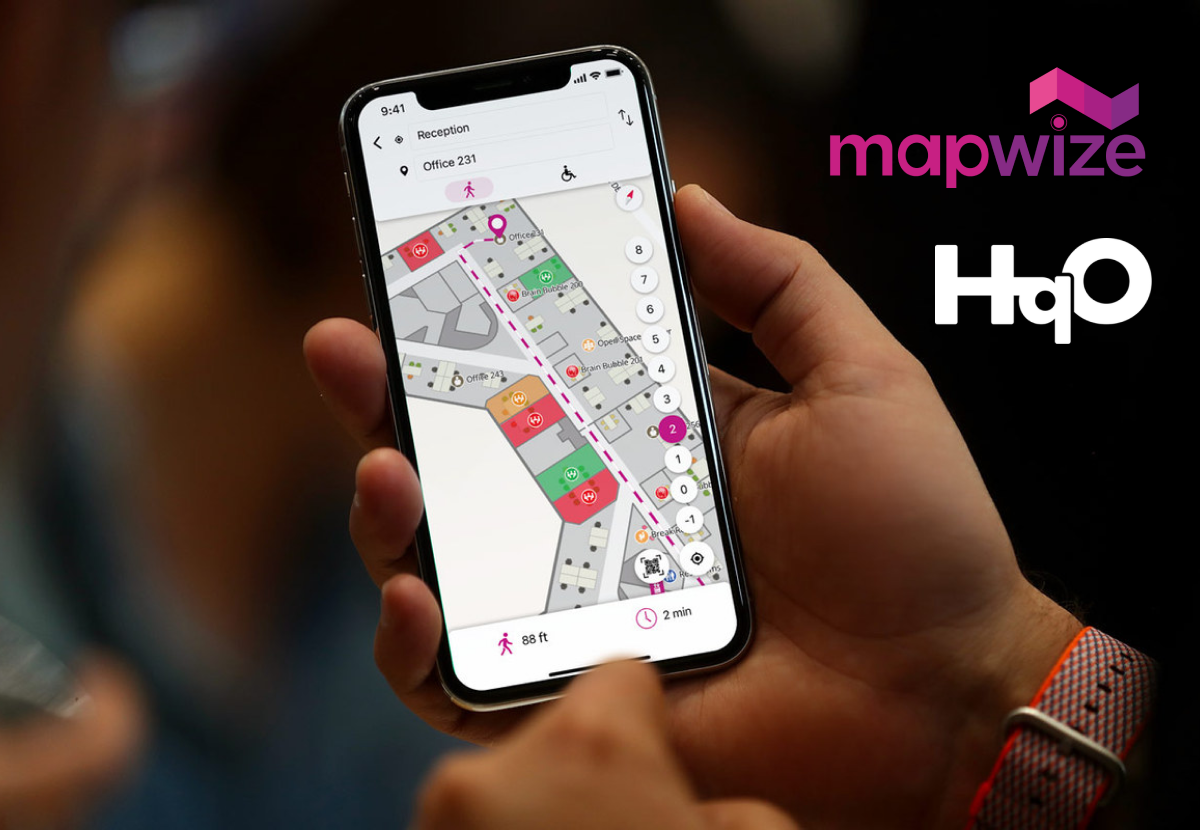We have all experienced that feeling of frustration when struggling to navigate a corporate office. From getting lost the first time you go to a company’s headquarters for a business meeting or job interview, to trying to locate the company restaurant on your first day, finding your way around can be nerve-wracking. Even in familiar buildings, time is lost to running around searching for the room where your next meeting is located, or scrambling through the hallways trying to find an available space you can use. Despite the ongoing need for better navigation tools, many buildings are still failing to offer tenants easy-to-use indoor maps and wayfinding tools.
At Mapwize, an HqOS Marketplace partner, we’re focused on delivering solutions for indoor wayfinding. Building owners are looking for ways to better manage the flow of employees and visitors as they navigate through the infrastructure. However, they are often surprised to find that the same tools can also be used to improve space management, locate equipment or empty areas at any time, and even to address changing layouts and flow patterns during pandemic periods.
Improve Employee Experience and Productivity
People are accustomed to using tools to find out how to get from one place to another, or to find things near their location. However, these capabilities often stop at the building entrance. Indoor maps and wayfinding can bridge the gap, providing employees with a better experience and cutting back on lost time.
One obvious use for indoor maps is to help employees find their way around the building or campus — and this can include more than directions to a meeting room. You can also include information on the location of equipment such as printers and coffee machines, safety areas, lockers, and restrooms. You can help employees find each other easily as well, by including your seating information. All of this information can be updated in real-time with minimal effort, ensuring your indoor maps are always accurate.
You can also use indoor maps to take the hassle out of meeting room booking. Because the maps update in real-time, you can display not only the location of meeting rooms, but also information on their availability and allow for booking. Indoor maps can be viewed on any device and in multiple languages, and offer seamless navigation between the indoors and outdoors when you have a multi-building complex.
Help Building Owners Make Data-Driven Decisions
One of the multiple use cases of indoor maps is to help visualize building-related data, helping owners gather new insights and make data-driven decisions. You can reduce real estate costs with the ability to visualize how office buildings are being used. For example, viewing meeting room booking data over an indoor map can provide valuable context to help understand usage patterns. Indoor maps can help bring real-time and dynamic time-range data to life, making it easier to identify which resources are being used and which ones are going to waste.
Prepare for a Safe Return to Work
Indoor maps and wayfinding become especially critical when preparing for employees to return to work following a health crisis like the Covid-19 pandemic. You can use them to quickly communicate new operating plans, including social distancing measures, one way routes, and the locations of hand sanitizer stations.
You can use real time data with indoor maps to help manage capacity in different areas of the building or campus. Tools such as HqO’s office Capacity Manager are useful for customers and tenants in managing the number of employees that come to the office on a given day.
Improve Security and Optimize Maintenance
Indoor maps and wayfinding software allows you to customize view and access levels for different groups. Security teams can have access to view the locations of security cameras or fire alarms positioning. This makes incident reporting and investigation easier, and can be used to optimize repair routes or to help with asset tracking.
Facility managers can have an even more detailed view of the workplace with real-time information about energy usage, space utilization, foot traffic through given areas, and equipment and systems currently in use. With this information, facility managers can monitor important systems (such as electricity, WiFi, HVAC, water, and telecoms) and even get alerts when something needs attention, reducing the time it takes to locate and resolve maintenance issues.
Boost Employer Brand
Companies use Indoor maps and wayfinding tools to communicate to both employees and visitors alike that they care about their people. They make it easier for people to work flexibly, find what they need, and reduce lost time. They can put a variety of information about the building features at the employee’s fingertips, making it easier for them to make the most of available amenities. As hot-desking and flexible working move mainstream, indoor maps and wayfinding software will become ever more useful.
Creating an indoor map and getting started with wayfinding is easier than most people expect. With a few clicks you can be well on your way to an improved employee experience, better data visualization, easier security and maintenance management and an improved employer brand.
To learn more about Indoor Mapping and Wayfinding solutions, and how Mapwize’s open platform can be integrated into your apps and used by your employees, visit our website or schedule a free demo today.
The opinions expressed by HqO Guest Bloggers and those providing comments are theirs alone, and do not reflect the opinions of HqO, any subsidiary or affiliate of the same, or any employee thereof. Although the articles are thoroughly reviewed by HqO staff, the views, opinions and positions expressed within these guest posts are those of the author alone. The accuracy, completeness and validity of any statements made within each article are not guaranteed. We accept no liability for any errors, omissions or representations. The copyright of this content belongs to the author and any liability with regards to infringement of intellectual property rights remains with them.



